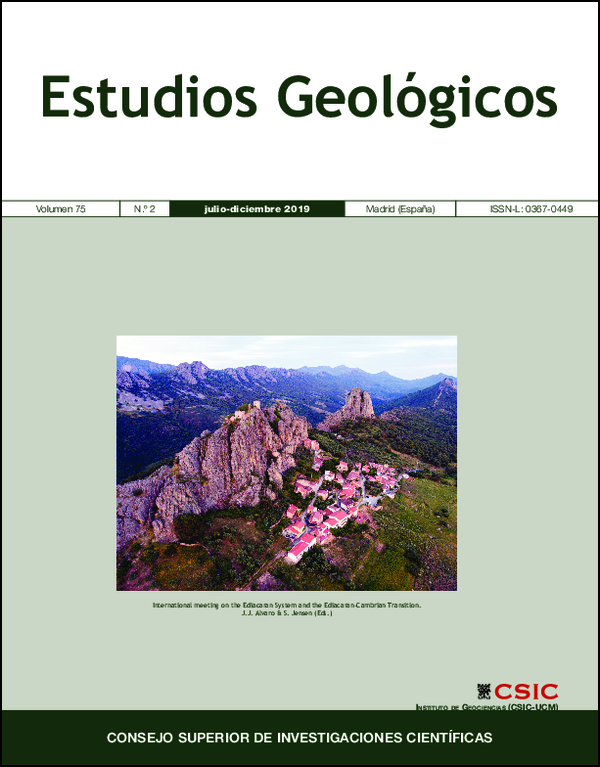Aspidella: the Ediacaran body fossil from the Jodhpur Sandstone of the Marwar Supergroup, Sursagar area, Jodhpur, western Rajasthan, India
DOI:
https://doi.org/10.3989/egeol.43593.564Keywords:
Aspidella, Jodhpur Sandstone, Ediacaran, Rajasthan, IndiaAbstract
This paper describes well-preserved Aspidella remains, the Ediacaran body fossils from the Jodhpur Sandstone of the Marwar Supergroup in Sursagar area, Jodhpur, western Rajasthan, India. They show distinct morphological features previously described in other famous Ediacaran fossil sites, such as the Fermuse Formation of Newfoundland, South Australia and White Sea of Russia
Downloads
References
Billings, E. (1872). On some fossils from the Primordial rocks of Newfoundland. Canadian Naturalist, 6: 465-479. https://doi.org/10.5962/bhl.title.38279
Chauhan, D. S.; Mathur, K. M. & Ram, N. (2001). Geological nature of the Pokaran boulder Bed: Palaeoenvironment, palaeoclimatic and stratigraphic implications. Journal of the Geological Society of India, 58: 425-433.
Chauhan, D. S.; Bhanwara Ram & Narayan Ram (2004). Jodhpur Sandstone: A gift of Ancient Beaches of Western Rajasthan. Geological Society of India, 64: 265-276.
Fedonkin, M.A.; Simonetta, A. & Ivantsov, A.Y. (2007). New data on Kimberella, the Vendian mollusc-like organism (White Sea region, Russia): palaeoecological and evolutionary implications. In: The Rise and Fall of the Ediacaran Biota (Vickers-Rich, P. & Komarower, P. eds). Geological Society, London, Special Publications, 286: 157-179. https://doi.org/10.1144/SP286.12
Gehling, J.G. (2000). Sequence stratigraphic context of the Ediacaran Member, Rownsley Quartzite, South Australia: A taphonomic window in to the Neoproterozoic biosphere. Precambrian Research, 100: 65-95. https://doi.org/10.1016/S0301-9268(99)00069-8
Gehling, J.G. & Narbonne, G.M. (2007). Spindle-shaped Ediacara fossils from the Mistaken Point assemblage, Avalon Zone, Newfoundland. Canadian Journal of Earth Sciences, 44: 367-387. https://doi.org/10.1139/e07-003
Gehling, J.G.; Narbonne, G.M. & Anderson, M.M. (2000). The first named Ediacaran body fossil, Aspidella terranovica. Palaeontology, 43: 427-456. https://doi.org/10.1111/j.0031-0239.2000.00134.x
Grazhdankin D.V. (2014). Patterns of evolution of the Ediacaran soft-bodied biota. Journal of Paleontology, 88: 269-283. https://doi.org/10.1666/13-072
Gregory, L.C.; Meert, J.G.; Bingen, B.H. Pandit, M.K. & Torsvik, T.H. (2009). Paleomagnetic and geochronologic study of Malani Igneous suite, NW India: implications for the configuration of Rodinia and the assembly of Gondwana. Precambrian Research, 170: 13-26. https://doi.org/10.1016/j.precamres.2008.11.004
Liu, A.G.; Kenchington, C.G. & Mitchell, E.G. (2015). Remarkable insights into the paleoecology of the Avalonian Ediacaran macrobiota. Gondwana Research, 27: 1355-1380. https://doi.org/10.1016/j.gr.2014.11.002
Menon, L.R.; McIlroy, D. & Brasier, M.D. (2013). Evidence for Cnidaria-like behavior in ca. 560 Ma Ediacaran Aspidella. Geology, 41: 895-898. https://doi.org/10.1130/G34424.1
Narbonne, G.M, & Gehling, J.G. (2003). Life after snowball: The oldest complex Ediacaran fossils. Geology, 31: 27-30. https://doi.org/10.1130/0091-7613(2003)031<0027:LASTOC>2.0.CO;2
Narbonne, G.M.; Laflamme, M.; Trusler, P.W.; Dalrymple, R.W. & Greentree, C. (2014). Deep-water Ediacaran fossils from Northwestern Canada: Taphonomy, ecology and evolution. Journal of Paleontology, 88: 207-223. https://doi.org/10.1666/13-053
Pandey, D.K. & Bahadur, T. (2009). A Review of the tratigraphy of Marwar Supergroup of west- central Rajasthan. Journal Geological Society of India, 73: 747-758. https://doi.org/10.1007/s12594-009-0060-6
Pareek, H.S. (1981). Configuration and sedimentary stratigraphy of western Rajasthan. Journal of the Geological Society of India, 22: 517-523.
Pareek, H.S. (1984). Pre-Quarternary geology and mineral resources of north- western Rajasthan. Memoirs of the Geological Survey of India, 115: 1-99.
Rathore, S.S.; Venkatesan, T.R. & Shrivastava, R.C. (1999). Rb -Sr isotope dating of Neoproterozoic (Malani group) magmatism from southwest Rajathan, India: evidence of younger Pan-African thermal event by 40Ar- 39Ar studies. Gondwana Research, 2: 271-281. https://doi.org/10.1016/S1342-937X(05)70151-9
Tarhan, L.G.; Droser, M.L.; Gehling, J.G. & Dzaugis, M.P. (2015). Taphonomy and morphology of the Ediacaran from genus Aspidella. Precambrian Research, 257: 124-136. https://doi.org/10.1016/j.precamres.2014.11.026
Published
How to Cite
Issue
Section
License
Copyright (c) 2019 Consejo Superior de Investigaciones Científicas (CSIC)

This work is licensed under a Creative Commons Attribution 4.0 International License.
© CSIC. Manuscripts published in both the print and online versions of this journal are the property of the Consejo Superior de Investigaciones Científicas, and quoting this source is a requirement for any partial or full reproduction.
All contents of this electronic edition, except where otherwise noted, are distributed under a Creative Commons Attribution 4.0 International (CC BY 4.0) licence. You may read the basic information and the legal text of the licence. The indication of the CC BY 4.0 licence must be expressly stated in this way when necessary.
Self-archiving in repositories, personal webpages or similar, of any version other than the final version of the work produced by the publisher, is not allowed.















